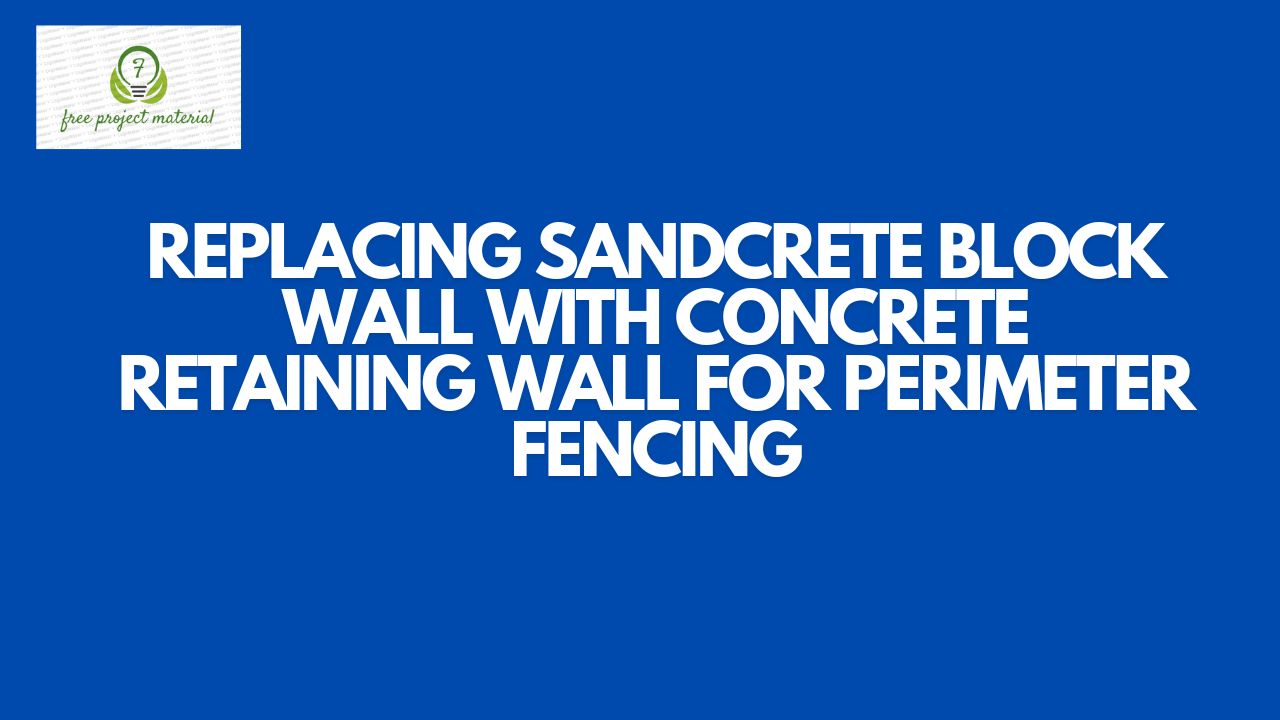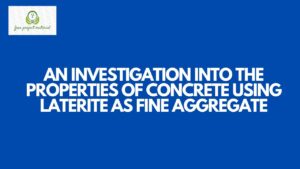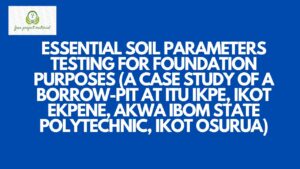ABSTRACT
The aim of this study was to examine the potential of concrete retaining wall over sandcrete block walls with close references the perimeter of fencing of some collapse sector of Akwa Ibom State Polytechnic perimeter fence at Ikot Osurua, Ikot Ekpene. This study revealed that that concrete wall is of better quality and more durable than sandcrete block wall and its use in place of sandcrete block is recommended due to its tensile strength and durability. The organizations responsible for setting and enforcing the minimum standard requirements should rise up to their billing and devise strategies aimed at ensuring that these standards are met in all respects by the manufacturers.
TABLE OF CONTENTS
Cover Page – – – – – – – – –
Certification – – – – – – – – –
Dedication – – – – – – – – –
Acknowledgements – – – – – – –
Abstract – – – – – – – – –
Table of Contents – – – – – – – –
CHAPTER ONE
INTRODUCTION
1.1 Background of the Study – – – – – –
1.2 Statement of the Problem – – – – – –
1.3 Aim and Objectives of the Study – – – –
1.4 Scope and Limitation of the study – – – –
1.5 Significance of the Study – – – – – –
1.6 Definition of Terms – – – – – –
CHAPTER TWO
REVIEW OF RELATED LITERATURE
2.1 Blocks Molding – – – – – – –
2.2 Quality of Sandcrete Blocks – – – – –
2.3 Standardization and Regulation of Quality – – –
2.4 Standard Requirements – – – – – –
2.5 Standard Enforcement – – – – – –
2.6 Standard Production Methods – – – – –
2.7 Check out these major advantages of concrete blocks: –
CHAPTER THREE
MATERIALS AND METHOD
3.1 Materials – – – – – – – –
3.2 Methods – – – – – – – –
CHAPTER FOUR
RESULT AND DISCUSSION
4.1 Results – – – – – – – –
4.2 Discussion – – – – – – – –
CHAPTER FIVE
CONCLUSION AND RECOMMENDATIONS
5.1 Conclusion – – – – – – – –
5.2 Recommendations – – – – – – –
REFERENCES
CHAPTER ONE
INTRODUCTION
1.1 Background of the Study
Observation has shown that many ancient buildings in Nigeria are made of clay works, presently still in existence and usable while a number of sandcrete block- made buildings have collapsed even before attaining their limit states. The fact remains that besides other factors that contribute to collapse of structures, material is a very key one that cannot be discountenanced. Sandcrete blocks seem to be an improvement over the clay bricks by cost and other factors, but does it really perfectly substitute the gradually fading clay block? Also the frequent failure of buildings in Nigeria is a concern to all stakeholders. In the past, incessant building failures have been reported resulting in the loss of lives and properties in Nigeria (Fakereet al, 2012; Oyekan& M., 2008). With this horrendous occurrence comes the need to review building materials (basically building blocks). Cost also is one of the major factors in construction that make people resign to use of spurious materials if at all they are determined to build. It therefore means that the review of materials such that a low-cost one be prescribed for users even without compromising standards is going to be a resourceful venture. Also, the need for locally manufactured building materials has been emphasized in many countries of the world. There is imbalance between the expensive conventional building materials coupled with depletion of traditional building materials. To address this situation, attention has been focused on low-cost alternative building materials (Agbede and Manasseh, 2008).
The composition of a sandcrete block is usually (1:6) mix of cement and sand moistened with water and allowed to dry naturally (Anosike and Oyebande, 2012). It is a composite material made up of cement, sand and water, moulded into different sizes (NIS 87, 2000). Sandcrete blocks are the commonest and most popular masonry walling units in Nigeria. The most essential and expensive constituent of the block is cement; to minimize cost and maximize profit, commercial producers of these blocks reduce the quantity of cement needed to give acceptable quality required by various standards. (Okafor and Ewa, 2012), Sandcrete blocks are the most widely used walling unit in Nigeria; accounting for 90% of houses (Baidenand Tuili, 2004).
Sandcrete block is relatively cheaper (more affordable) than other alternatives as a walling material for building construction in most developing countries with high housing deficit indices. While Concrete is summarily a man-made composite construction material consisting of mixed batches of fillers (fine aggregates & coarse aggregates) which are placed within the surrounding binder-paste (cement, water & air); under conditions that allow for ease of movement, curing and setting from its original plastic state to its final hardened state (Ibhadode et al., 2019). Sandcrete on the other hand, is simply a yellowish-whitish material used for building, which is produced from a cementitious binder—[usually Portland cement] and natural sand in a circa ratio of 1:8, with the addition of water—being the single most-utilized/consumed material worldwide, which may be sourced directly or indirectly from the nearby natural water sources like rivers. More often than not, Sandcrete in the form of a rectangular block— [which could be hollow or solid], is used in a very similar way as concrete masonry units to erect the walls of buildings (Ogbiye et al., 2019).
Walling materials constitute an essential element in housing delivery. It is estimated that it covers about 22% of the total cost of a building. The choice of walling material is a function of cost, availability of material, durability, aesthetics and climatic condition. Barry (1996) defines a wall as a continuous, usually vertical structure of brick, stone, concrete, timber or metal, thin in proportion to its length and height, which encloses and protects a building or serves to divide buildings into compartments or rooms.
1.2 Statement of the Problem
Defects and variations in construction products from standards is persistently a problem of concern in the construction industry in Nigeria, despite innovative technologies and quality education. The maintenance of quality is an important consideration in modern construction. This is evident by clients’ increasing use of companies’ reputations for good quality work as a basis for choosing prospective contractors. A review of the frequency of press reports of defective structures and the poor reputation of the construction industry for the quality of its products, suggest that there are problems of quality control in Nigeria.
Sandcrete blocks are composite materials made up of cement, sand and water, moulded into different sizes. They are widely used in Nigeria and virtually all African countries as walling unit. The quality of blocks produced however, differs from each industry due to the different methods employed in the production and the properties of the constituent materials. Ayeyemi (2008) stated that many factors have been identified for incessant building collapse in Lagos, but that critical step had not been taken to stop manufacturers of substandard sandcrete blocks whose product contributes a lot to the menace. It was also pointed out that these blocks produced by the manufacturers are sold at prices far below what a quality sandcrete block should cost. Oyekan (2007) observed that for a long time until perhaps few years ago these blocks were manufactured in many parts of Nigeria without due reference to any specifications either to suit local building requirements or for good quality work.
1.3 Aim and Objectives of the Study
The aim of this examine the potential advantage of using concrete retaining wall over sandcrete for perimeter fencing.
The objectives of this study are;
- To examine the level of deterioration of some section of the Akwa Ibom State Polytechnic collapse Fence
- To ascertain the causes of the collapsing of the fence
- To ascertain the nature of walling materials used
- To determine the quality of sandcrete block and concrete blocks
1.3 Scope and Limitation of the Study
This study will only focus on the potential benefits of replacing sandcrete block wall with concrete retaining wall with close preference to some collapse section of Akwa Ibom State Polytechnic perimeter fence. This study is limited due to time and financial constraints.
1.4 Significance of the Study
This study will help to inform the management of the institution on the need for the improvement of the structural condition of the perimeter fence of the institution.
To study will also help to ascertain the suitability of concrete block walls over sandcrete blocks, thereby serving as a basis for decision making by the management on preferably walling materials in order to obtain a long lasting construction of the perimeter fence.
This study will also serve as a source of information to builders, civil engineers and landlords on the best walling materials to use for perimeter fencing considering its consistent exposure to adverse environmental condition.
This study will also serve as a reference materials to students and researchers in this field of study.
1.5 Definition of Terms
Concrete: Concrete is summarily a man-made composite construction material consisting of mixed batches of fillers (fine aggregates & coarse aggregates) which are placed within the surrounding binder-paste (cement, water & air); under conditions that allow for ease of movement, curing and setting from its original plastic state to its final hardened state.
Sandcrete: Sandcrete on the other hand, is simply a yellowish-whitish material used for building, which is produced from a cementitious binder—[usually Portland cement] and natural sand in a circa ratio of 1:8, with the addition of water—being the single most-utilized/consumed material worldwide, which may be sourced directly or indirectly from the nearby natural water sources like river.
Blocks: This are basically building units, which are larger than bricks and are used for the erection of the walls and partitions in buildings.



